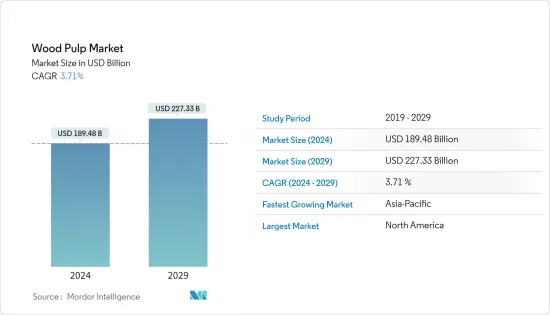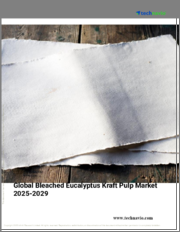
|
시장보고서
상품코드
1444370
세계의 목재 펄프 시장 : 점유율 분석, 산업 동향 및 통계, 성장 예측(2024-2029년)Wood Pulp - Market Share Analysis, Industry Trends & Statistics, Growth Forecasts (2024 - 2029) |
||||||
목재 펄프(Wood Pulp) 시장 규모는 2024년에 1,894억 8,000만 달러로 추정되며, 2029년까지 2,273억 3,000만 달러에 이를 것으로 예측되며, 예측 기간(2024-2029년) 동안 3.71%의 CAGR로 추이하며 성장할 것으로 전망됩니다.

주요 하이라이트
- 제지 산업의 목재 펄프 수요 증가, 티슈 페이퍼 제품에 대한 소비자 수요 증가, 목재 펄프 제품 무역의 성장 등이 시장의 동인으로 꼽힙니다. 시장에서 확인된 제약 요인은 삼림 벌채와 관련된 엄격한 환경 규제와 에너지 및 운송 비용 증가입니다.
- 미국은 전 세계 목재 펄프의 주요 생산국이며 브라질, 중국, 스웨덴이 다른 주요 펄프 생산국입니다. ITC 무역 데이터에 따르면, 2021년 목재 펄프의 총 수입량은 398만 톤으로 추정됩니다. 목재 펄프의 주요 수입국은 중국, 인도, 이집트, 한국입니다. 2021년에 중국은 전체 수입량의 40% 이상을 수입했으며, 이는 161만 톤으로 추정됩니다.
- 펄프의 주요 등급은 화학 펄프, 기계 및 반화학 펄프, 기타 펄프입니다. FAO 데이터에 따르면 2020년에 생산된 펄프의 78%는 화학 펄프 등급, 16%는 기계 및 반화학 등급으로 같은 해 생산량 1억 8,800만 톤 중 78%는 화학 펄프 등급이었습니다.
- 제지 산업은 목재 펄프의 주요 소비처 중 하나입니다. 2020년 FAOstat의 데이터에 따르면 주요 펄프 생산국은 미국이 4,990만 톤, 브라질이 2,100만 톤, 중국이 1,830만 톤을 생산한 것으로 나타났습니다. 그 외 주요 생산국으로는 캐나다, 스웨덴, 핀란드 등이 있습니다.
목재 펄프 시장 동향
종이 제품에 대한 소비자 수요 증가가 시장을 주도
주방, 화장실, 가정에서 필수적으로 사용되는 휴지에 대한 소비와 함께 전 세계적인 수요 증가가 예측 기간 동안 시장의 성장을 견인할 것으로 예상됩니다. 사람들이 개인 위생과 위생에 대한 인식이 높아지면서 펄프 기반 위생용품의 사용과 생산이 증가하고 있습니다. 또한 최근의 추세는 티슈 제조업체들이 목재 섬유와 재활용 종이 펄프를 사용하여 지속 가능하고 친환경적인 제품을 개발하고 플라스틱 기반 제품의 사용을 피하는 방향으로 나아가고 있습니다. 최근 휴지 및 기타 펄프 기반 위생용품에 대한 개발도상국의 수요가 증가하고 있습니다. 최근 몇 년 동안 수요가 증가하고 목재 펄프 생산량이 증가해 왔지만, 2019년 전 세계가 직면한 무역 문제로 인해 2020년에는 생산량이 감소했으며, 그 양은 1억 8,800만 톤으로 추정되며, 향후 몇 년 동안 장애가 없고 수요가 증가함에 따라 생산량이 증가할 것으로 예상됩니다.
미국은 세계에서 가장 많은 휴지를 소비하는 국가로, 1인당 연간 평균 25kg의 휴지를 소비합니다. 이 소비량의 약 37%가 키친타월을 통해 발생합니다. 캐나다는 전 세계 한대림의 24%를 보유하고 있으며 세계 최대의 펄프 및 제지 시장 중 하나입니다. 캐나다는 상당한 양의 원료를 생산하여 국내 및 국제 수요를 모두 충족하고 있습니다. ITC 무역 데이터에 따르면 2021년 전 세계 티슈 페이퍼의 총 수입액은 116억 달러로, 미국이 수입액의 12% 이상을 차지했습니다. 티슈 페이퍼 제품의 주요 수입국은 미국, 독일, 프랑스, 캐나다 등이며, 주요 수출국은 중국, 독일, 이탈리아, 미국 등입니다.
미국이 가장 큰 생산국
미국은 제지산업의 원료가 되는 침엽수림의 존재로 세계 최대의 목재 펄프 생산국입니다. FAOstat의 데이터에 따르면 2020년 미국 목재 펄프 생산량은 전 세계 총 목재 펄프 생산량의 26.8%를 차지했으며 2017년 대비 3.2% 증가한 5,080만 톤으로 추정되었습니다. 미국에는 24개국 이상에서 사업을 전개하는 International Papers, Georgia-Pacific Corp, Weyerhaeuser Corporation 등 세계 최대의 제지 회사가 여러 개 있습니다.
ITC Trade의 데이터에 따르면 2017년부터 2021년까지 미국에서 목재 펄프 수출이 대폭 증가했으며, 이 기간 동안 수출량은 200% 이상 증가하여 6만 3,727톤에 달했습니다. 미국은 특히 국내 소비 증가로 주요 수출국이 아니지만, 소비는 감소하고 있는 것 생산은 증가하고 있으며, 수요에 부응하기 위해 수출을 늘리고 있기 때문에 최근 시나리오는 변화하고 있습니다. 미국에서 목재 펄프의 생산과 수출은 강제 노동 기간 동안 강한 수요가 예상되기 때문에 증가할 것으로 예상됩니다.
목재 펄프 산업 개요
기타 혜택
- 엑셀 형식 시장 예측(ME) 시트
- 3개월의 애널리스트 서포트
목차
제1장 서론
- 조사 전제 조건 및 시장 정의
- 조사 범위
제2장 조사 방법
제3장 주요 요약
제4장 시장 역학
- 시장 개요
- 시장 성장 촉진 요인
- 시장 성장 억제 요인
- 밸류체인 분석
제5장 시장 세분화
- 지역
- 북미
- 미국
- 캐나다
- 유럽
- 독일
- 영국
- 프랑스
- 아시아 태평양
- 중국
- 호주
- 인도
- 남미
- 브라질
- 아르헨티나
- 중동 및 아프리카
- 남아프리카공화국
- 이집트
- 북미
제6장 시장 기회 및 향후 동향
LYJ 24.03.15The Wood Pulp Market size is estimated at USD 189.48 billion in 2024, and is expected to reach USD 227.33 billion by 2029, growing at a CAGR of 3.71% during the forecast period (2024-2029).

Key Highlights
- The drivers identified in the market are increasing demand for wood pulp from the paper industry, rising consumer demand for tissue paper products, and growth in the trade of wood pulp products. The restraints identified in the market are stringent environmental regulations with respect to deforestation and increasing energy and transportation costs.
- The United States is the major producer of wood pulp in the world, and Brazil, China, and Sweden are other major pulp producers. According to ITC Trade data, in 2021, the total import of wood pulp was estimated to be 3.98 million metric tons. The major importers of wood pulp are China, India, Egypt, and Korea. In 2021, China imported more than 40% of the total import quantity, which was estimated at 1.61 million metric tons.
- The main grades of pulp are chemical pulp, mechanical and semi-chemical pulp, and other pulp. According to FAO data, in 2020, 78% of the pulp produced was of chemical pulp grade and 16% was of mechanical and semi-chemical grade out of the 188 million metric tons of production volume recorded in the same year.
- The paper industry is one of the major consumers of wood pulp. In 2020, according to data from FAOstat, the leading pulp producers are the United States with 49.9 million metric tons, Brazil with 21 million metric tons, and China with 18.3 million metric tons. Other major producers include Canada, Sweden, Finland, etc.
Wood Pulp Market Trends
Rising Consumer Demand for Paper Products is Driving the Market
The rising global demand, along with consumption, for tissue paper, which is essentially used in kitchens, toilets, and households, is expected to drive the market's growth over the forecast period. As people become more aware of personal hygiene and sanitation, the use and production of pulp-based sanitary products are increasing. A recent trend is also pushing tissue-based manufacturers to develop sustainable and eco-friendly products by using wood fibers and recycled paper pulp and to avoid the use of plastic-based products. The demand from developing countries for tissue paper and other pulp-based sanitary products has been increasing in recent times. Though the demand has been on the rise and the production of wood pulp has been increasing in recent years, in 2020 the production was down due to the trade challenges faced across the globe in 2019, and the volume was estimated to be 188 million metric tons, which is expected to increase in the following years as there is no hindrance and the demand is increasing.
The United States is the largest consumer of tissue paper in the world; on average, 25 kg of tissue is consumed per person annually. About 37% of this consumption occurs via kitchen towels. Canada has 24% of the world's boreal forests and is one of the world's largest pulp and paper markets. The country produces a considerable amount of raw material, satisfying demand at both domestic and international levels. According to ITC Trade data. The total import of tissue papers across the globe in 2021 was valued at USD 11.6 billion, and the United States accounted for more than 12% of the import value. The major importers of tissue paper products are the United States, Germany, France, Canada, etc., and the major exporters are China, Germany, Italy, the United States, etc.
United States is the Largest Producer
The United States is the largest producer of wood pulp, globally, due to the presence of coniferous forest, which provides the raw material for the paper industry. In 2020 United states accounted for 26.8% of the world's total wood pulp production and was estimated to be 50.8 million metric ton a 3.2% increase from the 2017 volume, according to FAOstat data. The United States constitutes some of the biggest paper-producing companies in the world like International Papers, operating in more than 24 countries, Georgia-Pacific Corp, Weyerhaeuser Corporation, etc.
According to ITC Trade data, there has been a significant increase in the export of wood pulp from the United States from 2017 to 2021, the exports grew by more than 200% during the period and reached 63,727 metric ton. Though the United States is not a major exporter, especially due to the higher domestic consumption, the scenario is changing in recent years as consumption is decreasing but production is increasing which is boosting the export to cater to the demand. The production and export of in the United States for wood pulp are expected to increase as a strong demand is expected during the forceasted years.
Wood Pulp Industry Overview
Additional Benefits:
- The market estimate (ME) sheet in Excel format
- 3 months of analyst support
TABLE OF CONTENTS
1 INTRODUCTION
- 1.1 Study Assumptions and Market Definition
- 1.2 Scope of the Study
2 RESEARCH METHODOLOGY
3 EXECUTIVE SUMMARY
4 MARKET DYNAMICS
- 4.1 Market Overview
- 4.2 Market Drivers
- 4.3 Market Restraints
- 4.4 Value Chain Analysis
5 MARKET SEGMENTATION
- 5.1 Geography
- 5.1.1 North America
- 5.1.1.1 United States
- 5.1.1.2 Canada
- 5.1.2 Europe
- 5.1.2.1 Germany
- 5.1.2.2 United Kingdom
- 5.1.2.3 France
- 5.1.3 Asia-Pacific
- 5.1.3.1 China
- 5.1.3.2 Australia
- 5.1.3.3 India
- 5.1.4 South America
- 5.1.4.1 Brazil
- 5.1.4.2 Argentina
- 5.1.5 Middle East and Africa
- 5.1.5.1 South Africa
- 5.1.5.2 Egypt
- 5.1.1 North America
















